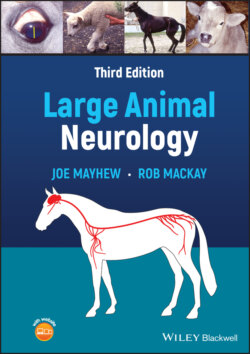Читать книгу Large Animal Neurology - Joe Mayhew - Страница 29
Mental status
ОглавлениеAn assessment of mental status is made based on the patient’s level of awareness or consciousness that is evidenced by bodily activity seen as a state of arousal. This may well require considerable forebrain functions to be active but requires input from the ascending reticular activating system (ARAS) in the rostral brainstem and thalamus for the state of arousal to be maintained (see Figure 1.7). The level of activity in the ARAS is affected by inputs received by all components of the sensory nervous system, particularly from the special senses of smell, sight and sound, and from noxious inputs. Coma is a state of complete unresponsiveness to noxious stimuli and the deepest comas are usually related to rostral brainstem or particularly thalamic lesions within the ARAS. Semicoma is a state of partial or inappropriate responsiveness to stimuli. Other, less profound, levels of loss of awareness are variously described as stupor, obtundation, somnolence, delirium, lethargy, and inactivity. The term depression is to be avoided in describing suppressed activity in animals because of the subjective connotations it includes in human medicine. Large animals that are recumbent because of spinal cord disease are usually bright and alert unless they are anorectic, dehydrated, exhausted, or unduly frightened.
Prominent changes in behavior and a markedly dampened mental attitude are seen with many forms of forebrain disease, especially those of traumatic, inflammatory, toxic, and metabolic origin. The signs can often fluctuate considerably over minutes to days, and such cases may quickly alternate between a somnolent, unresponsive state to one of hyperexcitability and violent behavior.
Disordered sleep patterns, particularly paroxysmal episodes of sleep as seen with narcolepsy, may require CCTV video monitoring to be seen and to help distinguish from seizures.
